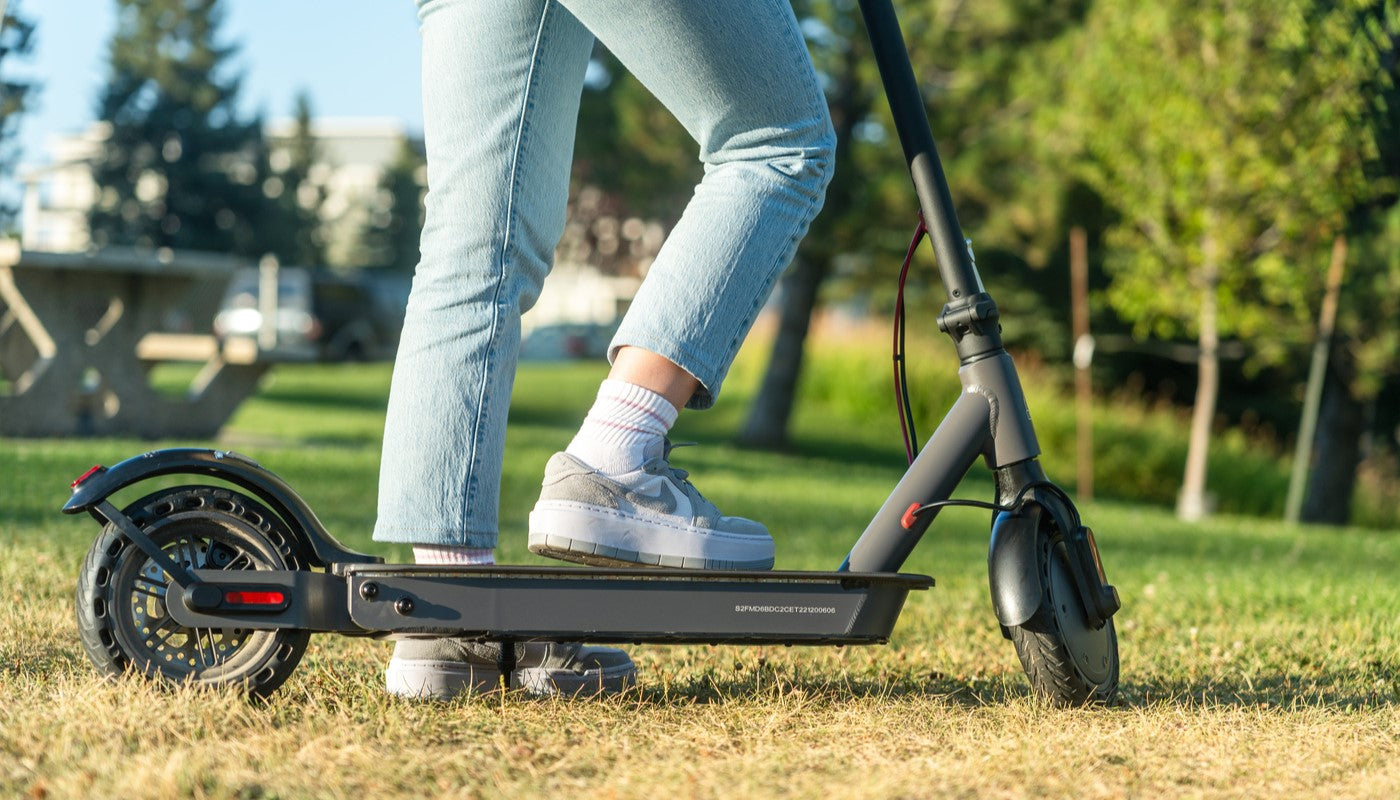Electric scooters (e-scooters) have surged in popularity across Canada, offering an eco-friendly, convenient alternative to cars and public transit. However, navigating the complex web of regulations can be challenging due to varying rules across provinces and municipalities. This guide provides a clear, up-to-date overview of e-scooter laws in Canada as of June 2025, covering federal and provincial roles, definitions, recent changes, licensing, insurance, penalties, and practical tips for riders. Whether you're a daily commuter or a casual rider, understanding these regulations will help you ride safely and avoid fines.
Federal vs. Provincial Jurisdiction: Who Makes the Rules?
In Canada, e-scooter regulations are split between federal and provincial governments. The federal government oversees product safety standards under the Motor Vehicle Safety Act, ensuring e-scooters meet manufacturing requirements like brakes and labeling. However, provinces and municipalities control day-to-day usage rules, such as where you can ride, speed limits, and safety requirements. This creates a patchwork system, meaning rules in Vancouver differ from those in Toronto or Montreal. Crossing provincial or municipal borders can lead to unintentional violations, so always check local bylaws before riding.
Definition of Electric Scooters Under Canadian Law
E-scooters are typically classified as power-assisted bicycles or motor-assisted cycles if they meet specific criteria:
-
Motor power: ≤500 watts
-
Maximum speed: 24–32 km/h (varies by province)
-
Weight: ≤45 kg (in some provinces, e.g., Ontario)
-
Design: Handlebars, a standing platform, and two wheels
These definitions align with federal standards but vary provincially. For example:
-
Ontario: Caps speed at 24 km/h and weight at 45 kg under its pilot program.
-
British Columbia: Treats e-scooters as motor-assisted cycles, allowing up to 32 km/h.
-
Quebec: Allows 32 km/h and classifies them as bicycles if ≤500W.
High-powered scooters (>500W or >32 km/h) may be considered limited-speed motorcycles, requiring licensing, registration, and insurance. The Motor Vehicle Safety Act doesn’t explicitly address e-scooters, leaving provinces to fill the gap, which can lead to confusion as new models push regulatory boundaries.
Recent Legislative Changes (2023–2025)
E-scooter regulations are evolving rapidly as cities and provinces adapt to growing micro-mobility trends. Below are key updates based on available information:
-
Ontario: The e-scooter pilot program, launched in 2020, was extended to November 27, 2029. Municipalities can opt in via bylaws, setting rules for helmets, age, and parking. For example, Mississauga allows e-scooters on roads and bike lanes, while Toronto prohibits them on public streets, sidewalks, and trails. Toronto’s May 2024 council decision reaffirmed this ban, citing safety concerns, including a rise in injuries.
-
British Columbia: The e-scooter pilot, started in 2021, is extended through 2028. E-scooters are allowed on bike lanes and roads ≤50 km/h, with a 24 km/h speed limit, mandatory helmets for all, and lights/bells for night riding. Vancouver and Kelowna have embraced shared programs with geofencing. A “light e-bike” category (≤25 km/h, 14+ riders) was introduced in April 2024.
-
Quebec: A pilot program runs until 2026, allowing e-scooters on bike paths and roads ≤50 km/h, with a 25 km/h limit and mandatory helmets for all. A July 2024 ban prohibits non-compliant scooters (e.g., those resembling mopeds without federal safety marks) on public roads and bike paths due to safety risks. Montreal ended its rental program in 2019 but allows private e-scooters under strict rules.
-
Alberta: Calgary and Edmonton permit e-scooters on bike lanes and pathways, with no license required, a 16+ age limit (19+ for rentals), and helmet encouragement.
-
Saskatchewan: E-scooters are prohibited on public roads unless municipalities opt in (e.g., Saskatoon’s pilot allows bike lane use, 16+, helmets).
-
Transport Canada: No specific 2025 manufacturing standards (e.g., speed limiters, enhanced brakes) are confirmed. However, a 2021 change shifted focus to on-road vs. off-road use, leaving safety standards to provinces.
-
Insurance: No province mandates liability insurance for standard e-scooters (≤500W, ≤32 km/h) as of 2025. High-powered scooters classified as motorcycles may require insurance in provinces like BC or Quebec.
Riders should verify updates via provincial websites as pilot programs evolve.
How Canadian Regulations Compare to Other Countries
Canada’s e-scooter rules are moderately restrictive compared to global standards:
-
United States: Varies by state. California allows 24 km/h with no helmet for adults; some states permit up to 48 km/h for certain devices.
-
Europe: The EU enforces a 25 km/h limit and helmet requirements in some countries (e.g., France requires registration). The UK restricts private e-scooters to private property, with rental pilots ongoing as of 2023; no 2024 legalization is confirmed.
-
Australia: Queensland requires licenses for scooters >200W; helmets are mandatory nationwide.
-
New Zealand: Allows up to 30 km/h on bike paths, no license or helmets for adults.
Canada’s enforcement is less strict than Singapore’s (fines up to S$2,000) but more regulated than New Zealand’s permissive approach. The table below summarizes key differences:
|
Country |
License Required? |
Speed Limit |
Helmet Required? |
|
Canada |
No (standard scooters); Yes (high-powered) |
24–32 km/h |
Varies (e.g., Quebec: Yes; Ontario: <18) |
|
US |
Varies (most states: No) |
24–48 km/h |
Varies (often No for adults) |
|
France |
Yes (registration) |
25 km/h |
Yes |
|
UK |
No (rentals only) |
25 km/h |
Recommended |
|
Australia |
Yes (>200W in QLD) |
25 km/h |
Yes |
Provincial Electric Scooter License Requirements
British Columbia
-
Rules: No driver’s license for standard e-scooters (≤24 km/h, ≤500W). Riders must be 16+, wear helmets, and use bike lanes or roads ≤50 km/h. Lights and bells are required for night riding.
-
Municipal Variations: Vancouver uses geofencing for rentals, prohibiting sidewalks and major roads like the Seawall.
Ontario
-
Pilot Program: Extended to 2029, allows municipal bylaws. Requirements include 16+ age, helmets for <18, max 24 km/h, no passengers, and no sidewalk riding.
-
Municipal Variations: Mississauga permits e-scooters on roads and bike lanes; Toronto bans them on public spaces, with fines up to $2,500 for violations.
Quebec
-
Rules: E-scooters (≤25 km/h, ≤500W) require no license, 14+ age, helmets for all, and bike lane/road use (≤50 km/h). Non-compliant scooters are banned as of July 2024.
-
Municipal Variations: Montreal enforces strict parking and speed rules; rentals are banned post-2019.
Prairie Provinces
-
Alberta: No license, 16+ to own, 19+ for rentals, helmets encouraged. Allowed on bike lanes and pathways in Calgary and Edmonton.
-
Saskatchewan: Prohibited on public roads unless municipalities allow (e.g., Saskatoon: 16+, helmets, bike lanes).
-
Manitoba: Winnipeg allows e-scooters on bike paths but bans them on roads and sidewalks. No license, helmets for <18.
Maritime Provinces
-
Nova Scotia: E-scooters are motor vehicles, requiring licenses, registration, and insurance, making them impractical. Halifax is exploring pilots.
-
New Brunswick: No specific laws; tolerated on bike paths and quiet streets. Formal rules are under consideration.
-
Prince Edward Island: Likely treated as motor vehicles; no clear 2024 guidelines confirmed.
Municipal Variations in E-Scooter Rules
Toronto
-
E-scooters are not allowed on public roads, bike lanes, sidewalks, or trails due to Toronto’s opt-out from the provincial pilot (reaffirmed May 2024). Fines range from $150–$2,500 for violations. Use is restricted to private property. Safety concerns, including a rise in injuries, drive this ban.
Vancouver
-
Embraces e-scooters via a pilot extended to 2028. Rules include 16+, helmets for all, 24 km/h limit, and bike lane/road use (≤50 km/h). Geofenced zones and apps (e.g., Lime, Neuron) guide riders.
Montreal
-
Private e-scooters are allowed under Quebec’s pilot (14+, helmets, 25 km/h, bike lanes). Rentals are banned post-2019. Fines ($50+) apply for improper parking or sidewalk riding.
Smaller Cities
-
Kelowna: Canada’s first e-scooter sharing program (2019), uses geofencing.
-
Calgary: Permits e-scooters on bike lanes/paths, with dynamic speed zones.
-
Ottawa: Seasonal adjustments for winter, designated parking zones, 20 km/h limit.
-
Saskatoon/Halifax: Community-driven pilots with bike lane focus.
Key Factors That Determine License Requirements
Speed and Power
-
Standard E-Scooters (≤500W, ≤32 km/h): No license required in most provinces (e.g., Ontario: 24 km/h, Quebec: 25 km/h, BC: 24 km/h).
-
High-Powered Scooters (>500W, >32 km/h): Treated as limited-speed motorcycles, requiring a motorcycle license (e.g., BC Class 6/8, Ontario M-class).
Where You Ride
-
Bike Lanes/Paths: Generally license-free for standard e-scooters.
-
Roads: Allowed on roads ≤50 km/h in BC, Quebec, and some Ontario/Alberta cities. High-powered scooters on roads may need licenses.
-
Sidewalks: Prohibited nationwide to protect pedestrians.
-
Private Property: No license or restrictions.
Age Restrictions
-
Ontario: 16+, helmets for <18.
-
Quebec: 14+, helmets for all.
-
BC: 16+, helmets for all.
-
Alberta: 16+ (19+ for rentals), helmets encouraged.
-
Saskatchewan/Manitoba: 16+, helmets vary.
How to Get Licensed (If Required)
For standard e-scooters, no specific license is needed in most provinces. For high-powered scooters classified as motorcycles:
-
Application: Visit provincial licensing offices (e.g., ICBC in BC, ServiceOntario). Provide ID, proof of residency, and pass a vision test.
-
Tests: Written knowledge test and practical skills test for motorcycle licenses (e.g., Ontario M2, BC Class 8).
-
Fees: $25–$80 initial, $20–$70 renewal (1–5 years), depending on province.
-
Training: Optional rider courses (1–2 days) improve skills and may lower insurance costs.
Check with your province’s transportation ministry for specifics. No evidence supports mandatory e-scooter-specific training or online courses as of 2025.
Insurance Considerations
No province mandates liability insurance for standard e-scooters (≤500W, ≤32 km/h) as of 2025. For high-powered scooters:
-
Mandatory: In provinces like BC or Quebec, if classified as motorcycles.
-
Voluntary: Costs $100–$300/year via providers like Intact or TD Insurance. Home policies often exclude e-scooters, so check coverage.
-
Advocacy: Groups are exploring insurance products for e-scooters.
Penalties for Non-Compliance
Violating e-scooter rules can lead to:
-
Fines: $100–$500, depending on province and offense (e.g., Ontario: $250–$2,500 for pilot violations; BC: $276 for no helmet; Ottawa: $150 for sidewalk riding).
-
Insurance Risks: Unlicensed riding (for high-powered scooters) voids coverage, leaving you liable for damages.
-
Repeat Offenses: Escalating fines, potential impoundment, or mandatory courses ($150–$300) in some municipalities.
-
Criminal Offenses: Dangerous or impaired riding is a Criminal Code violation, with severe penalties.
Rental Scooters vs. Personally Owned Scooters
-
Rentals: Operate under municipal pilots with stricter rules (e.g., speed limiters, GPS tracking, designated parking). Companies like Lime and Bird handle maintenance, insurance, and data reporting. Requirements include 18+ (16+ with consent) and safety tutorials.
-
Personal Scooters: Follow provincial/municipal rules, which may be less restrictive but vary widely (e.g., Toronto bans, Ottawa allows).
Practical Tips for Canadian E-Scooter Riders
-
Stay Informed:
-
Follow provincial websites and city social media.
-
Set Google Alerts for “e-scooter [your city]” for updates.
-
Join local forums or groups for rider insights.
-
Safety Gear:
-
Wear a certified helmet (mandatory in Quebec, BC, Saskatchewan; <18 in Ontario).
-
Equip your scooter with a bell, front white light, and rear reflector for night riding.
-
Consider reflective clothing, knee/elbow pads, and gloves, especially in winter.
-
Use Apps:
-
Rental apps (Lime, Bird, Neuron) show permitted zones and parking areas.
-
Transit apps or Waze can map bike lanes for safe routes.
-
Ride Responsibly:
-
Stick to bike lanes and roads ≤50 km/h where allowed; avoid sidewalks.
-
Yield to pedestrians and use bells when passing on shared paths.
-
Park in designated zones to avoid fines ($50–$150).
-
Advocacy:
-
Engage with groups to push for clearer, standardized laws.
-
Participate in municipal consultations to support e-scooter integration.
Conclusion
E-scooters are transforming urban mobility in Canada, but their patchwork regulations require riders to stay vigilant. By understanding federal, provincial, and municipal rules, equipping your scooter properly, and following safety guidelines, you can enjoy a compliant and fun ride. Always check local bylaws, especially in cities like Toronto, where bans persist, or Vancouver, where pilots thrive. As Canada’s cities expand bike lane networks and pilot programs, e-scooters are poised to become a key part of sustainable transport. Ride smart, stay safe, and keep up with the evolving rules!











Share:
Are 750-Watt Electric Bikes Legal in Canada?
Can You Get a Dui on a Bike? Thing You Must Know